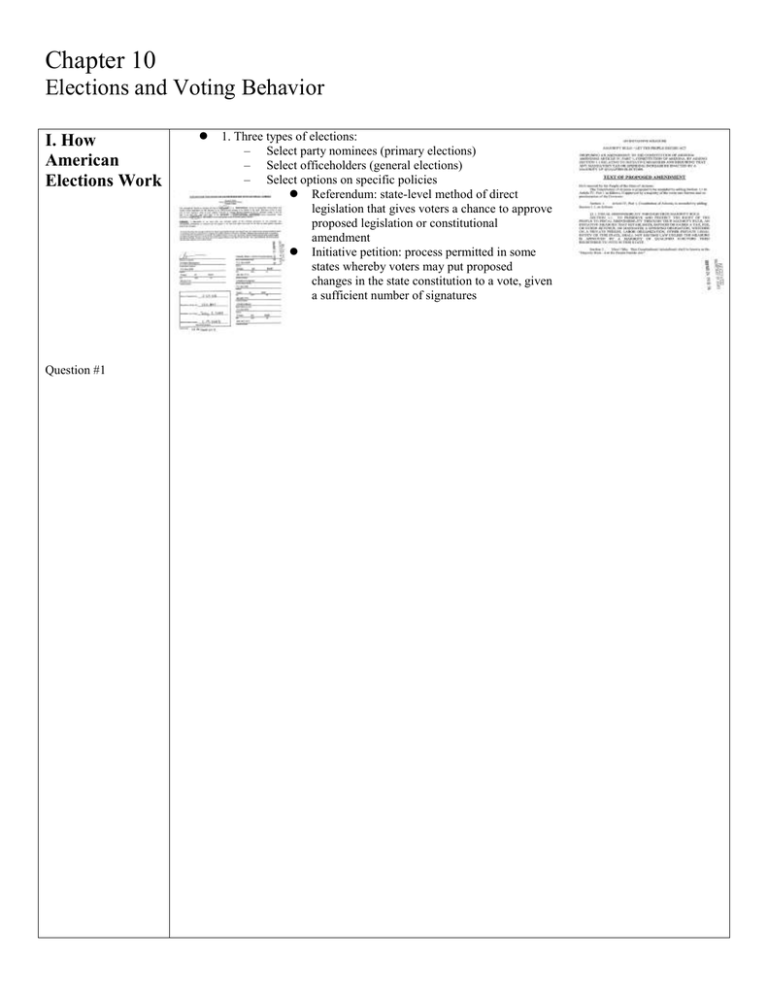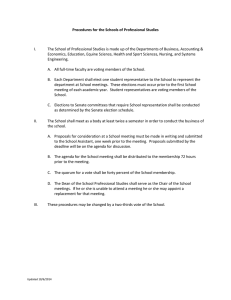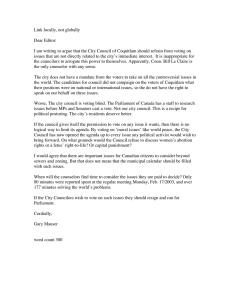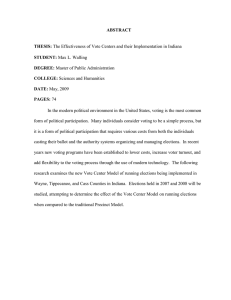Chapter 10 Elections and Voting Behavior I. How American
advertisement

Chapter 10 Elections and Voting Behavior I. How American Elections Work Question #1 1. Three types of elections: – Select party nominees (primary elections) – Select officeholders (general elections) – Select options on specific policies Referendum: state-level method of direct legislation that gives voters a chance to approve proposed legislation or constitutional amendment Initiative petition: process permitted in some states whereby voters may put proposed changes in the state constitution to a vote, given a sufficient number of signatures II. THE EXPANSION OF VOTING RIGHTS A. Two Long Trends Question #1 1. Federal laws and constitutional amendments have eliminated restrictions on the right to vote, thus dramatically expanding the American electorate. 2. Federal laws and constitutional amendments have significantly reduced the power of individual states over a citizen's right to vote. B. The Original Electorate Question #2 1. In 1789, property and tax qualifications restricted the electorate to white male property owners. 2. Only about one in fifteen adult white males had the right to vote. C. Jacksonian Democracy Question #3 1. Andrew Jackson and his supporters had great respect for the common sense and abilities of the common man. As a result, the Jacksonians eliminated property ownership and tax payments as qualifications for voting. 2. By 1850, almost all white adult males had the right to vote. D. The 15th Amendment, 1870 1. The Fifteenth Amendment prohibited voting restrictions based on "race, color, or previous condition of servitude." Question #4 2. Despite the Fifteenth Amendment, a combination of literary tests, poll taxes, white primaries, and the grandfather clause systematically disenfranchised African Americans. E. The 19th Amendment, 1920 1. Prior to 1920, women had full voting rights in New York and a number of Western states. 2. The Nineteenth Amendment removed voting restrictions based on gender. Question #5 F. The 23rd Amendment, 1961 Question #6 1. Prior to 1961, residents of the District of Columbia could not vote in presidential elections. 2. The Twenty-Third Amendment added voters of the District of Columbia to the presidential electorate. G. The 24th Amendment, 1964 1. Prior to 1964, a number of states used poll taxes as a means of discouraging citizens from voting. 2. The Twenty-Fourth Amendment outlawed the poll tax "or any tax" as a qualification for voting. Question #7 H. The Voting Act of 1965 Question #8 1. Prohibited any government from using voting procedures that denied a person the vote on the basis of race or color. 2. Abolished the use of literacy requirements for anyone who completed the sixth grade. 3. Authorized federal registrars to protect African Americans' right to vote in Southern states and counties with histories of discrimination. I. The 26th Amendment, 1971 1. The 26th Amendment provides that the minimum age for voting in any election cannot be less than 18 years. 2. Note that a state may set a minimum voting age of less than 18. Question #9 Summary #1 III. Whether to Vote: A Citizen’s First Choice 1. Suffrage: the legal right to vote – Extended to African-Americans by the Fifteenth Amendment – Extended to Women by the Nineteenth Amendment – Extended to people over 18 years of age by the Twenty-Sixth Amendment 2. Deciding Whether to Vote – U.S. has low voter turnout – Downs: it is rational to not vote Those who see clear differences between parties are likely to vote. If indifferent, then one may rationally abstain from voting. – Political Efficacy: the belief that one’s political participation really matters – Civic Duty: the belief that in order to support democratic government, a citizen should always vote 3. Registering To Vote – Voter Registration: a system adopted by the states that requires voters to register well in advance of the election day – Registration procedures differ by state. – Motor Voter Act: passed in 1993, requires states to permit people to register to vote when they apply for their driver’s license 4. Who Votes? – Education: More education = more likely to vote. Most important factor – Age: Older = more likely to vote – Race: Caucasian = more likely to vote. BUT, other ethnicities are higher with comparable education – Gender: Female = more likely to vote – Marital Status: Married = more likely to vote – Union Membership: Union member = more likely to vote – Traits are cumulative - possessing several adds up D. How Americans Vote: Explaining Citizens’ Decisions 1. Mandate Theory of Elections – The idea that the winning candidate has a mandate from the people to carry out his or her platforms and politics – Politicians like the theory better than political scientists do. 2. Party Identification – People still generally vote for a party they agree with. – With the rise of candidate-centered politics, parties’ hold on voters declined in the 1960s and 1970s. – Many more voters make an individual voting decision and are up for grabs each election, (so-called floating voters). 3. Candidate Evaluations: How Americans See the Candidates – Candidates want a good visual image. Especially on dimensions of integrity, reliability, and competence – Personality plays a role in vote choice, especially if a candidate is perceived to be incompetent or dishonest. 4. Policy Voting – Basing your vote choice on issue preferences and where the candidates stand on policy issues – Policy voting may occur if : Voters know where they and the candidates stand on issues and see differences between candidates – Unlikely to occur because: Candidates can be ambiguous on the issues. Media tend to focus on the “horse race” not issues. – Today candidates are forced to take a clear stand in the party primaries increasing chances for policy voting. E. Electoral College Question #10 Question #11 Question #12 1. Electoral college actually elects the president—founders wanted him chosen by the elite of the country 2. States choose the electors Article II Section 1. The executive Power shall be vested in a President of the United States of America. He shall hold his Office during the Term of four Years, and, together with the Vice President, chosen for the same Term, be elected, as follows Each State shall appoint, in such Manner as the Legislature thereof may direct, a Number of Electors, equal to the whole Number of Senators and Representatives to which the State may be entitled in the Congress: but no Senator or Representative, or Person holding an Office of Trust or Profit under the United States, shall be appointed an Elector. Electors are often chosen to recognize service and dedication to their political party. They may be Stateelected officials, party leaders, or persons who have a personal or political affiliation with the Presidential candidate. 3. Winner-Take-All system gives bigger emphasis to more populated states . How it works today: On Election Day, the voters in each State choose the Electors by casting votes for the presidential candidate of their choice. The Electors’ names may or may not appear on the ballot below the name of the candidates running for President, depending on the procedure in each State. The winning candidate in each State—except in Nebraska and Maine, which have proportional distribution of the Electors—is awarded all of the State’s Electors. In Nebraska and Maine, the state winner receives two Electors and the winner of each congressional district receives one Elector. This system permits the Electors from Nebraska and Maine to be awarded to more than one candidate. Each state has as many votes as it does Representatives and Senators. Winner of popular vote typically gets all the Electoral College votes for that state AZ List of Electors Electors meet in December, votes are reported by the vice president in January If no candidate gets a majority (270 votes), the House of Representatives votes for president, with each state casting one vote. Video #1 This 7 minute clip discusses the pros and cons of the Electoral College system, as well as focusing on alternatives, such as the national popular vote, district, and proportional plans. Video #2 In this 9 minute clip, U.S. Senate Associate Historian Don Ritchie discusses faithless electors, the district plan, and the pros and cons of the Electoral College with historical examples to help illustrate his points. Video #3 In this 3 minute clip, Birch Bayh discusses the negative aspects of the Electoral College and his alternative, the National Popular Vote Plan. 2012 Election Scenarios 1. Swing state- In politics, a "swing state" is a state in which neither party (Republican or Democrat) can claim a decisive historical advantage. For this reason, a "swing state" could vote either way, which makes integral states to campaign in. Some examples of swing states: Ohio, Florida Summary #2 F. Understanding Elections and Voting Behavior 1. Democracy and Elections – The greater the policy differences between candidates, the more likely voters will be able to steer government policy by their choices. Unlikely—candidates do not always clarify issues positions – Candidates who vow to continue popular policies are more likely to win elections. – Retrospective voting: voters cast a vote based on what a candidate has done for them lately Those who feel worse off are likely to vote against incumbents. Bad economies make politicians nervous. 2. Elections and the Scope of Government – Elections generally support government policies and power. – Voters feel they are sending a message to government to accomplish something – Thus, the government expands to fill the needs of the voters. Summary Voters make two basic decisions at election time: – Whether to vote – Who to vote for Party identification, candidate evaluations, and policy positions drive vote choice. Elections are fundamental to a democracy.







